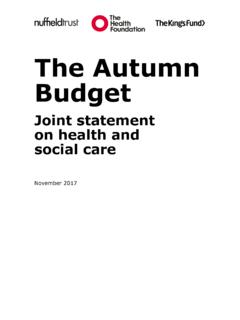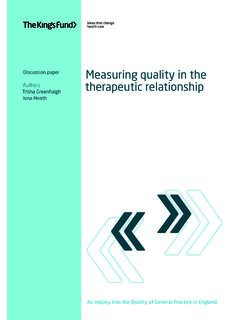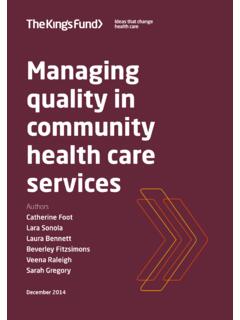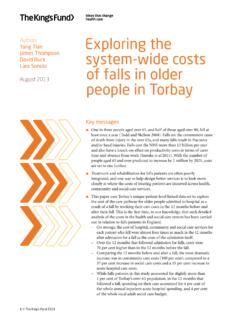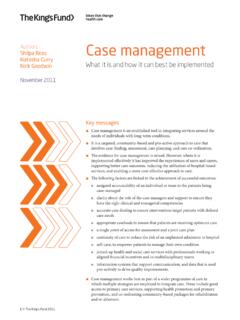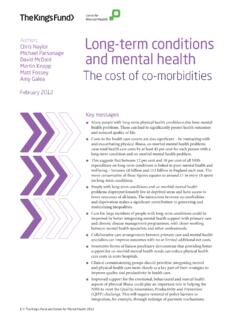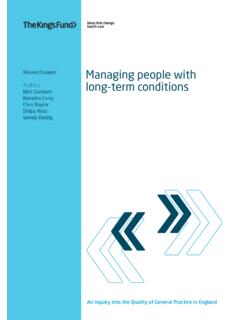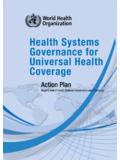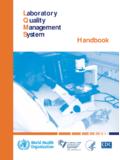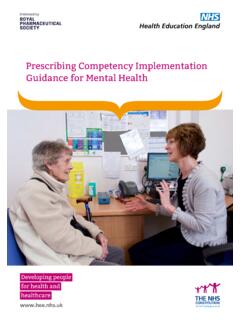Transcription of Managing acute illness - King's Fund
1 Managing acute illness Research paperAuthorsRoger JonesPatrick WhiteDavid ArmstrongMark AshworthMarilyn PetersAn Inquiry into the Quality of General Practice in EnglandManaging acute illnessRoger JonesWolfson Professor of General PracticePatrick WhiteSenior Lecturer in General PracticeDavid ArmstrongProfessor of Medicine and SociologyMark AshworthSenior Lecturer in General PracticeMarilyn PetersResearch Co-ordinatorDepartment of Primary Care and Public Health SciencesKing s College LondonThis paper was commissioned by The King s Fund to inform the Inquiry panel. The views expressed are those of the authors and not of the panel. 2 The King s Fund 2010 Contents1 Introduction 3 Defining acute illness 3 The scope of the report 3 Method of working 42 The clinical content of general practice 6 3 Presentations in general practice 7 acute minor illness 7 acute major illness 84 Identifying quality in the care of acute illness 12 acute distress 13 Patient perspectives 14 The consultation 15 Quality of diagnosis 16 Quality of treatment 16 Quality of referral 195 Conclusions 23 References 243 The King s Fund 20101 IntroductionAs part of the Inquiry into the Quality of General Practice, The King s Fund commissioned this research project to examine the management of acute illness (both minor and serious).
2 In common with the other projects commissioned as a part of the Inquiry, the research team was tasked with examining: the role of general practice; what good quality of care looks like in terms of patient care and cost-effectiveness; how good quality care can be measured (metrics); and to make a current assessment of what is known about the current quality of acute illness management in general practice. This report identifies four categories of acute illness before considering the possibilities for proposing quality markers, under the headings of acute distress, patient perspectives, the consultation in general practice, the quality of diagnosis, the quality of treatment, including prescribing, and the quality of acute illnessAcute illnesses are those that are of short duration. They may be minor or they may be serious. Minor acute illnesses include some of the commonest problems presented in general practice, such as upper respiratory tract infections or skin rashes.
3 Major acute illnesses may present as an acute exacerbation of an underlying chronic illness , such as a myocardial infarction or diabetic coma, or the sudden onset of a previously undiagnosed condition, such as epilepsy or stroke or an acute emotional or psychological of rapid onset can pose a diagnostic puzzle (and are therefore the remit of another working group), but they can be significant in determining whether the underlying problem is acute , in the sense of being self-limiting, or not. We have therefore included the problem of triaging acute presentation into minor and serious problems. acute is also often encountered in a lay sense as meaning serious , but we believe that this usage is also encompassed in our coverage of acute illnesses and acute our contribution to the inquiry, we have classified acute illness as: acute minor illness (self-limiting) acute major illness (self-limiting or requiring treatment) acute presentation of existing major illness ( acute exacerbation) acute presentation of new chronic illness .
4 The scope of the reportThe structure of the National Health Service (NHS), established over 60 years ago, re-emphasised the sharp divide between primary and secondary care. This has resulted in a number of characteristic features of general practice, including its generalist orientation, its gatekeeper role, the referral system, and a range of issues to do with access to investigations and specialist opinions across the interface between primary and secondary The King s Fund 2010 Although general practice remains the main site of first-contact medical care in the United Kingdom, a number of alternative routes to first-contact or primary care have emerged in the past decade or so, including walk-in clinics, accident and emergency departments (with some A&E departments employing general practitioners as first-contact clinicians), NHS Direct, minor injury and minor illness units (often nurse-led), general dental practitioners, optometrists, and, most recently, screening clinics and the NHS Health Check.
5 These may be located in commercial settings, GP surgeries or local pharmacies. In this review we focus on general practitioner care, recognising that even within a general practice first-contact care may be provided in a range of ways, including GP consultations, nurse practitioner triage and first-contact practice nurse and health visitor consultations, telephone consultations and personal or deputising services to provide out-of-hours care. Other projects that are part of this inquiry focus specifically on diagnosis, referral, choice, access and continuity or co-ordination of care, and we touch on these too in considering the important issue of the quality of management of acute indicated in the research brief, the medical geography of any general practice is important in considering the measurement of quality. Factors such as practice size and structure, the location of a practice in relation to the base hospital and its emergency services, local arrangements for direct access to investigations, and the availability of on-site investigations will all modulate aspects of how acute illness is managed and how its quality is of workingWe began our research by conducting a literature review with the aim of identifying studies that examined approaches to evaluating quality measures for the management of acute illness .
6 The literature in this area was relatively sparse, and few studies were available to guide the preparation of this series of discussions took place between the authors of the report, culminating in a seminar conducted at the Department of General Practice and Primary Care at King s College London on 29 July 2009. At the event we received input from clinical, academic and NHS general practitioners, academics, practice nurses and managers, departmental administrators and lay people. This seminar informed the development of our ideas. In particular, we attempted to test our ideas about quality metrics against an actual clinical problem in this case, the management of a patient presenting acutely with cough and found this approach very useful in teasing out the components of then presented our ideas to The King s Fund Expert Seminar, which took place on 24 September 2009, and modified the paper in the light of the discussions that took place there.
7 We later conducted a further seminar with general practitioners and members of our department in order to further refine our ideas. Our draft proposals for quality measures were presented at The King s Fund on 3 March 2010. Using the feedback from that meeting, we developed and summarised these measures into a Quality Measure Template. These quality measures represent what we believe represent potential ways to capture what good quality of care looks like in the management of people with acute GP Inquiry Paper5 The King s Fund 2010GP Inquiry Paperillness. The template includes an assessment of the potential for each of the measures to be used for gaming purposes (to earn more money from the Quality and Outcomes framework than is merited from a true assessment of performance) or to have unintended consequences. Finally, we conducted a further literature review to establish whether there was any evidence that some of our quality improvement proposals (such as significant event analysis, audit with feedback, note review and peer review) had been tested in research settings.
8 The findings of this review are included at the end of the The King s Fund 20102 The clinical content of general practiceIn recent years there has been an emphasis on the role of general practice in the management of long-term conditions and the so-called secondary-to-primary care shift. In the NHS, this has culminated in the introduction of the Quality and Outcomes framework (QOF)1 element of the new GP contract, which is composed of financial incentives relating mostly to chronic illness . Alongside these changes, GPs remain responsible for assessing the majority of acutely ill scale of the management of acute illness is impressive: while new and follow-up attendances at hospital outpatient departments total about 41,600,000 per year, with about 20,000,000 A&E attendances, there are more than 280,000,000 GP consultations in England each year, with a mean annual consultation rate per individual member of the population of around five per to two-thirds of primary care contacts are for acute problems, although the reasons for consultation and the content of the consultation are often more complex than the presentation and treatment of a single episode might suggest.
9 The term acute is likely to have somewhat different meanings in different contexts. Cough is said to become chronic after eight weeks2 and diarrhoea after six,3 but given the likelihood that patients symptoms will often have been present for some time before the decision to consult, these figures must be regarded as minor illness might be regarded as the bread and butter of general practice, but much major illness that finds its way into hospital through emergency admissions (such as coronary heart disease, stroke, chronic obstructive pulmonary disease and acute gastrointestinal disorders) is first seen by GPs and referred into assessment of acutely and potentially seriously ill patients in community settings is a core skill of general practice, and has major implications for medical education and vocational training schemes, which need to equip GPs to deal better with major illness . Evidence gathered by the General Medical Council, reflected in the recent edition of Tomorrow s Doctors,4 suggests that recently qualified doctors in the United Kingdom are concerned about their ability to evaluate seriously ill people.
10 The continuing restrictions imposed by the European Working Time Directive (EWTD) are likely to exacerbate this The King s Fund 20103 Presentations in general practiceThis section is divided into two subsections: acute minor illness and acute major minor illnessOne of the distinguishing features of the clinical content of primary and general practice care, compared with secondary care, is the undifferentiated nature of the problems presented by patients to GPs. Patients bring symptoms that are often partially developed (and sometimes difficult to describe) at an early stage in the evolution of illness , long before a firmer diagnosis has resulted in a hospital outpatient referral. Indeed, Thomas, writing in the 1980s, estimated that up to 40 per cent of patients that he saw in his Hampshire practice were suffering from a condition to which it was difficult to give a precise name, coining the telling phrases the temporarily dependent patient and the therapeutic illusion.
